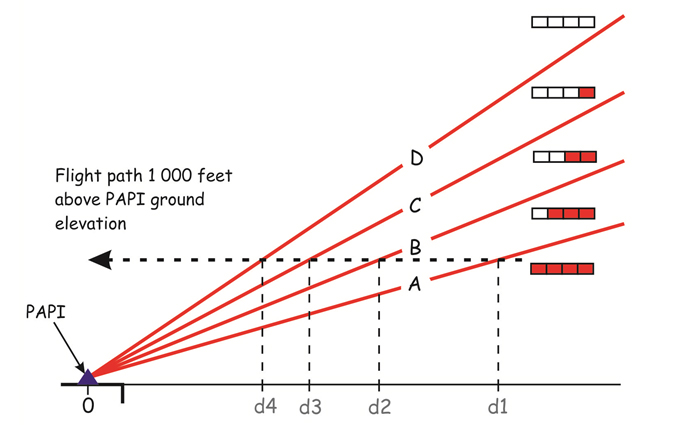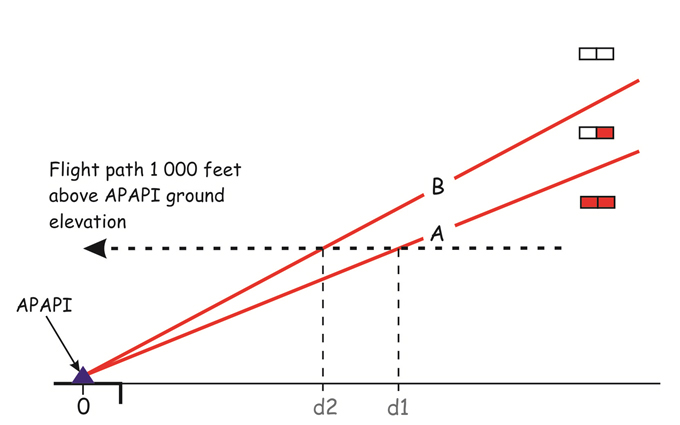Precision Approach Path Indicator Flight Check
| Issuing Office: | Civil Aviation, Standards | Document No.: | AC 300-014 |
|---|---|---|---|
| File Classification No.: | Z 5000-34 | Issue No. | 01 |
| RDIMS No.: | 11343347 | Effective Date: | 2016-07-27 |
- 1.0 Introduction
- 2.0 References and Requirements
- 3.0 Background
- 4.0 Responsibilities
- 5.0 In-Flight Inspection Procedure
- 6.0 Summary
- 7.0 Information Management
- 8.0 Document History
- 9.0 Contact Office
1.0 Introduction
- (1) This Advisory Circular (AC) is provided for information and guidance purposes. It may describe an example of an acceptable means, but not the only means, of demonstrating compliance with regulations and standards. This AC on its own does not change, create, amend or allow deviations from regulatory requirements, nor does it set up standards.
1.1 Purpose
- (1) The purpose of this document is to outline methodologies for conducting a flight check to identify gross misalignment errors of Precision Approach Path Indicator (PAPI) and Abbreviated Precision Approach Path Indicator (APAPI) lighting systems.
1.2 Applicability
- (1) This document applies to all aerodrome operators using PAPI and APAPI lighting systems. This information is also available to the aviation industry for information purposes.
1.3 Description of Changes
- (1) Not applicable
2.0 References and Requirements
2.1 Reference Documents
- (1) It is intended that the following reference materials be used in conjunction with this document:
- (i) Part III, Subpart 2 of the Canadian Aviation Regulations (CARs) – Airports;
- (ii) Transport Canada publication, TP 312 – Aerodrome Standards and Recommended Practices – 4th ed.;
- (iii) Transport Canada publication, TP 312 – Aerodrome Standards and Recommended Practices – 5th ed. (effective 09/2015); and
- (iv) Advisory Circular (AC) No. 302-009 - Precision Approach Path Indicator Harmonization with Instrument Landing System.
2.2 Cancelled Documents
- (1) Not applicable.
- (2) By default, it is understood that the publication of a new issue of a document automatically renders any earlier issues of the same document null and void.
2.3 Definitions and Abbreviations
- (1) The following abbreviations are used in this document:
- (a) AC: Advisory Circular
- (b) APAPI: Abbreviated Precision Approach Path Indicator
- (c) CARs: Canadian Aviation Regulations
- (d) OPS: Obstacle Protection Surface
- (e) PAPI: Precision Approach Path Indicator
- (f) TCCA: Transport Canada Civil Aviation
- (g) TP: Transport Canada Publication
3.0 Background
- (1) The PAPI/APAPI lighting systems specified in TP 312, section 5.3.16, are designed to provide visual glide slope indication to pilots for use in the operation of their aircraft safely in all variable weather conditions, by day and by night. To maintain a proper presentation of the on-course section to approaching aircraft, the angle settings of the individual light units of the system need to be monitored and always properly maintained. Failure to maintain the specified angle settings could result in compromising the obstacle clearance provided to approaching aircraft.
- (2) Periodic measurement of the PAPI / APAPI should be conducted by the aerodrome operator to verify that the lights are operating to applicable standards and manufacturers' recommendations as described within their aerodrome's preventive maintenance program.
4.0 Responsibilities
- (1) Regulatory roles: It is airport operators' responsibility as per Part III of the CAR to ensure that their airside lighting is correctly installed, inspected and maintained in accordance with published specifications of TP 312, manufacturers' specifications and recommended maintenance procedures; including the verification of the angle settings for the individual PAPI / APAPI light units.
- (2) Verification - A flight check of PAPI / APAPI is not required for calibration purposes. An aircraft is not a suitable platform to determine the compliance of the system to the accuracy level required by the standards. Only a field calibration with manufacturer's tools/procedures can establish/determine proper setting of the light beam angles.
- (3) In the case of PAPI / APAPI installations, regular/ongoing verifications should focus on the demonstration of proper maintenance procedures/activities to capture any misalignment before these become gross alignment errors.
- (4) Failure to maintain the specified angle settings could result in compromising visual presentation of the on-course sector to approaching aircraft, and having the aircraft approach at a shallower slope, thereby being closer than desired to obstacles. Periodic verification of the Obstacle Protection Surface (OPS) should also form part of the airport operators' preventive maintenance program to ensure the surface is clear of all obstacles.
- (5) As part of normal oversight activities, an in-flight assessment may be performed to detect any gross alignment errors in the system. Should such errors be detected, the airport operator should immediately assess the alignment, and correct as required, or remove the system from service pending correction.
5.0 In-Flight Inspection Procedure
- (1) Should an airport operator wish to proceed with an in-flight assessment of the system to identify any gross alignment errors, the assessment should be conducted as follows:
- (a) Input the PAPI / APAPI coordinates (degrees/minutes/seconds) into the aircraft navigation system;
- (b) Establish and maintain the aircraft at an altitude of 1 000 feet AGL at the PAPI / APAPI location;
- (c) Track inbound (at 1 000' AGL) on an extended final starting at a distance greater than 4 NM. The PAPI / APAPI system should be operating at maximum intensity; and
- (d) Note the distance at which the system becomes visible for use, and where the colour transitions are observed. Observed colour changes should be near the distances presented in the table below. Colour transition time between the boxes should be consistent throughout all light units. Repeat the sequence as required to confirm any observed significant differences.
Figure 1: Flight Path through light beams
| Note: Distance (NM) is from PAPI / APAPI position. | |||||||
| PAPI | APAPI | ||||||
|---|---|---|---|---|---|---|---|
| Slope (degrees) |
Unit A (d1) |
Unit B (d2) |
Unit C (d3) |
Unit D (d4) |
Slope (degrees) |
Unit A (d1) |
Unit B (d2) |
| 3.0° | 3.77 NM | 3.33 NM | 2.97 NM | 2.69 NM | 3.0° | 3.43 NM | 2.90 NM |
| 3.5° | 3.14 NM | 2.83 NM | 2.57 NM | 2.35 NM | 3.5° | 2.90 NM | 2.51 NM |
| 4.0° | 2.69 NM | 2.46 NM | 2.26 NM | 2.09 NM | 4.0° | 2.51 NM | 2.21 NM |
| 4.5° | 2.35 NM | 2.17 NM | 2.02 NM | 1.88 NM | 4.5° | 2.21 NM | 1.98 NM |
- (2) Other subjective in-flight assessment elements are:
- (a) Range (normally 4NM or greater)
Possible issues: weak or misaligned lamps, dirty filters or lenses - (b) Colour transition sharpness
Possible issues: weak or misaligned lamps, dirty filters or lenses - (c) PAPI – ILS harmonization (where applicable)
Possible issues: angle settings, PAPI / APAPI location -
Note: See Advisory Circular No. 302-009 - Precision Approach Path Indicator Harmonization with Instrument Landing System for guidance on ILS harmonization.
- (d) Symmetry of displays on both sides of runway (where provided)
Possible issues: angle settings, installation distance from threshold not the same on both sides.
- (a) Range (normally 4NM or greater)
- (3) An in-flight assessment should be conducted during periods of the day where the glare from the sun will not impede the pilots' ability to see the signal from the PAPI units.
6.0 Summary
- (1) Airport operators are responsible for ensuring the continued compliance of the PAPI/APAPI systems to the stipulated requirements in accordance with Part III of the CARs – Aerodromes, Airports, and Heliports, and associated standards in TP312 - Aerodrome Standards and Recommended Practices.
- (2) In the case of PAPI / APAPI installations, this requires demonstration (documentation) by the certificate holder that the units are installed in accordance with standards, and calibrated/maintained in accordance with manufacturer's procedures. Regular/ongoing verifications should focus on the demonstration of proper maintenance procedures/activities to capture any misalignment before these become gross alignment errors.
- (3) An in-flight assessment may be performed to detect any gross alignment errors in the system. Should any such errors be detected, the airport operator should immediately assess the alignment, and correct as required, or remove the system from service pending correction.
7.0 Information Management
- (1) Not applicable.
8.0 Document History
- (1) Not applicable.
9.0 Contact Office
For more information, please contact the appropriate TCCA Regional Office listed at the following address: https://tc.canada.ca/en/corporate-services/regions
Suggestions for amendment to this document are invited, and should be submitted via: TC.Flights.Standards-Normesdevol.TC@tc.gc.ca
[original signed by]
Robert Sincennes
Director, Standards
Civil Aviation

